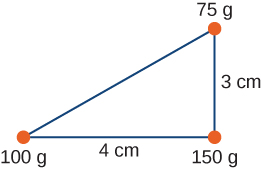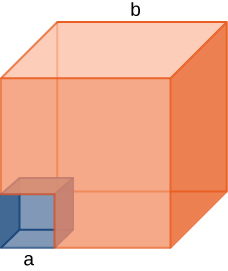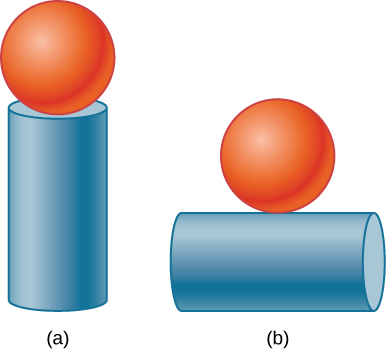| << Chapter < Page | Chapter >> Page > |
The explanation of this apparently astonishing coincidence is: We defined the center of mass precisely so this is exactly what we would get. Recall that first we defined the momentum of the system:
We then concluded that the net external force on the system (if any) changed this momentum:
and then—and here’s the point—we defined an acceleration that would obey Newton’s second law. That is, we demanded that we should be able to write
which requires that
where the quantity inside the parentheses is the center of mass of our system. So, it’s not astonishing that the center of mass obeys Newton’s second law; we defined it so that it would.
Suppose a fireworks shell explodes, breaking into three large pieces for which air resistance is negligible. How does the explosion affect the motion of the center of mass? How would it be affected if the pieces experienced significantly more air resistance than the intact shell?
Three point masses are placed at the corners of a triangle as shown in the figure below.

Find the center of mass of the three-mass system.
With the origin defined to be at the position of the 150-g mass, and
Two particles of masses and separated by a horizontal distance D are released from the same height h at the same time. Find the vertical position of the center of mass of these two particles at a time before the two particles strike the ground. Assume no air resistance.
Two particles of masses and separated by a horizontal distance D are let go from the same height h at different times. Particle 1 starts at , and particle 2 is let go at . Find the vertical position of the center of mass at a time before the first particle strikes the ground. Assume no air resistance.
Two particles of masses
and
move uniformly in different circles of radii
and
about origin in the
x ,
y -plane. The
x - and
y -coordinates of the center of mass and that of particle 1 are given as follows (where length is in meters and
t in seconds):
and:
Two particles of masses
and
move uniformly in different circles of radii
and
about the origin in the
x ,
y -plane. The coordinates of the two particles in meters are given as follows (
for both). Here
t is in seconds:
a. , ; b. ; c. yes, with
Find the center of mass of a one-meter long rod, made of 50 cm of iron (density ) and 50 cm of aluminum (density ).
Find the center of mass of a rod of length L whose mass density changes from one end to the other quadratically. That is, if the rod is laid out along the x -axis with one end at the origin and the other end at , the density is given by , where and are constant values.
Find the center of mass of a rectangular block of length a and width b that has a nonuniform density such that when the rectangle is placed in the x , y -plane with one corner at the origin and the block placed in the first quadrant with the two edges along the x - and y -axes, the density is given by , where is a constant.
Find the center of mass of a rectangular material of length a and width b made up of a material of nonuniform density. The density is such that when the rectangle is placed in the xy -plane, the density is given by .
A cube of side a is cut out of another cube of side b as shown in the figure below.

Find the location of the center of mass of the structure. ( Hint: Think of the missing part as a negative mass overlapping a positive mass.)
Find the center of mass of cone of uniform density that has a radius R at the base, height h , and mass M . Let the origin be at the center of the base of the cone and have + z going through the cone vertex.
Find the center of mass of a thin wire of mass m and length L bent in a semicircular shape. Let the origin be at the center of the semicircle and have the wire arc from the + x axis, cross the + y axis, and terminate at the − x axis.
Find the center of mass of a uniform thin semicircular plate of radius R . Let the origin be at the center of the semicircle, the plate arc from the + x axis to the −x axis, and the z axis be perpendicular to the plate.
Find the center of mass of a sphere of mass M and radius R and a cylinder of mass m , radius r , and height h arranged as shown below.

Express your answers in a coordinate system that has the origin at the center of the cylinder.

Notification Switch
Would you like to follow the 'University physics volume 1' conversation and receive update notifications?